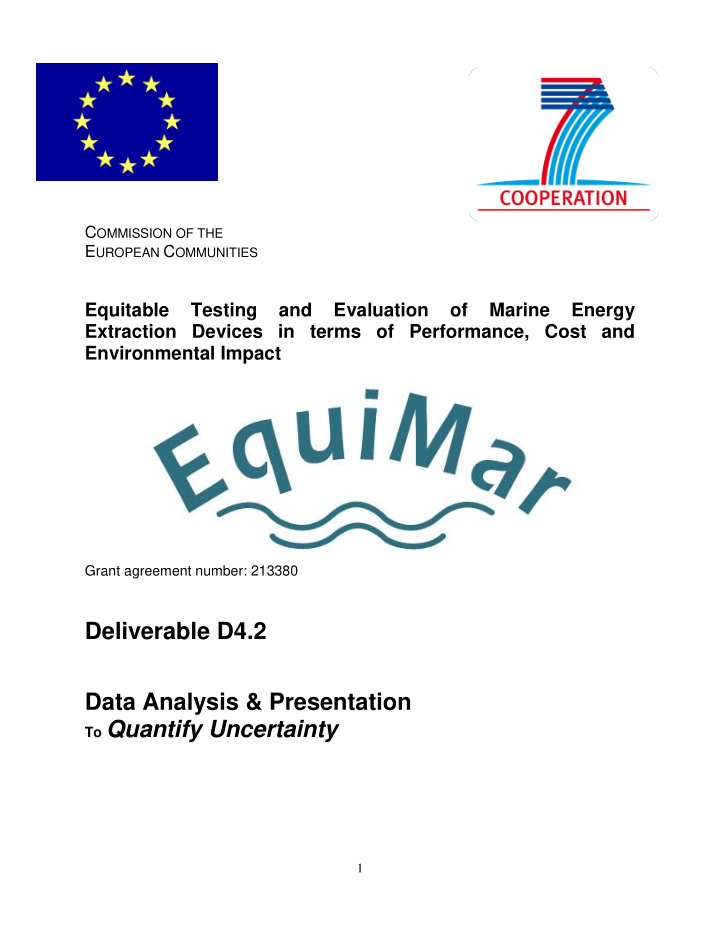



C OMMISSION OF THE E UROPEAN C OMMUNITIES Equitable Testing and Evaluation of Marine Energy Extraction Devices in terms of Performance, Cost and Environmental Impact Grant agreement number: 213380 Deliverable D4.2 Data Analysis & Presentation To Quantify Uncertainty 1
Grant Agreement number: 213380 Project acronym: E QUI M AR Project title: Equitable Testing and Evaluation of Marine Energy Extraction Devices in terms of Performance, Cost and Environmental Impact Deliverable D4.2 Data Analysis & Presentation To Quantify Uncertainty J.P. Kofoed, A. Pecher, L. Margheritini Aalborg University B. Holmes University College Cork T. McCombes, C. Johnstone University of Strathclyde C. Bittencourt DNV C. Retzler Pelamis Wave Power L. E. Myers University of Southampton November, 2010 Dissemination Level: PU, Public 2
Content Content .......................................................................................................................................................... 3 ................................................................................................................................................ 4 Nomenclature 1 Introduction ........................................................................................................................................... 5 1.1 Rationale ....................................................................................................................................... 5 1.2 ............................................................................................................................................. 6 Scope 1.3 Introduction to the procedure ........................................................................................................ 6 2 Performance assessment at test location ............................................................................................... 9 2.1 Environmental matrix ................................................................................................................... 9 2.2 Zoning ......................................................................................................................................... 10 2.3 ............................................................................................... 10 Selection of the performance data 2.4 ............................................................... 11 Statistical evaluation of data points in indicated zones 2.5 Presentation of the performance ................................................................................................. 13 2.6 Fine-tune the model .................................................................................................................... 15 2.6.1 Adjusting the zoning ........................................................................................................... 15 2.6.2 Introduction of new data ..................................................................................................... 15 2.6.3 ............................................... 15 Application of the procedure for different conversion steps 2.6.4 ............................................................................. 15 Include more environmental parameters 3 Performance at another target location ............................................................................................... 18 3.1 Applying the new Environmental Matrix ................................................................................... 18 3.2 ................................................................................................ 19 Complementing the sea trial data 4 ....................................................................... 21 Marine energy resource and power output uncertainty 4.1 .............................................................. 21 Marine energy resource and conversion characteristics 4.1.1 Tidal energy ........................................................................................................................ 21 4.1.2 ....................................................................................................................... 22 Wave Energy 4.2 Grid codes and power quality requirements................................................................................ 23 5 Executive summary ............................................................................................................................. 24 6 ........................................................................................................................................... 25 References 3
Nomenclature CI Confidence interval CL Confidence level ̿ Environmental matrix Significant wave height derived from spectral moments, 4 √ m 0 H mo LOI Location of interest n Amount of data points P Converted Power Prob Probability of occurrence P avail Power available from the resource P average Yearly average converted power P wave Wave power s Sample standard deviation Statistical parameter representing the confidence level of the confidence interval T e Energy Period (m -1 /m 0 ) v Water speed ̅ Sample mean Non-dimensional performance 4
1 Introduction 1.1 Rationale The Sea Trial Manual (D4.1) describes the type of operations required to advance an ocean energy conversion device (wave and tide) from an intermediate scaled sub-systems proving machine (circa 1:4) to a full size solo prototype pre-production unit and on towards a pre-commercial device ready for economic evaluation in a small array deployment. This progression covers development Stages 3 to 4 in the 5 Stage development programme on which the EquiMar technical protocols are based. The process spans a large range of engineering development and introduces heavy offshore operations, device certification, health and safety considerations, environmental issues, regulatory and permit requirements and improved economic predictions. An important factor that strongly influences these two Stages is that they are conducted at outdoor test sites were conditions occur by nature so they must be accepted rather than controlled or produced on demand. This applies equally to wave and tidal technologies: although tidal conditions are considered predictable, local conditions experienced by a device are strongly influenced by Spring-Neap cycles and weakly or non-deterministic, locally correlated events such as depth varying turbulent structures, wind-wave-current interaction etc. Sea trial programmes must, therefore, be robust enough to accommodate this loss of predictability so requires the careful selection of a test site(s) and extended deployment durations. Unfortunately, time equates to escalating costs for the device development companies undertaking the sea trials with the inevitable reality that it is probable fully completed programmes will be rarely achieved. A standard methodology to specify the degree of completion of the test programmes is required and by which to express the level of confidence, or degree of uncertainty that dictates the risk assessment for continuing forward. There are three approaches that can be adopted to, firstly, improve the confidence limit and secondly, quantify (or qualify) the risk. These are: Conduct analysis of the sea states occurring at the test site to calculate the probability of survival, or extreme, events occurring within specified deployment durations Conduct analysis of the sea states occurring at the open water test site to evaluate the scatter of metocean conditions from the station average and the deviation of the average from a classical form, such as Bretschneider for wave fields or predicted conditions based on surface measurements or numerical results in the case of tidal velocity. These factors will influence the range of device performance characteristics. Based on the above and the number of device settings to be investigated, plan the sea trial programme to ensure all important events are experienced and captured. Ideally, the programme would require several performance observations to be made in each element of a site‟s met ocean conditions (e.g. a bi-variate H m0 -T e sea state scatter diagram for wave energy or a velocity-direction-depth scatter diagram for tidal) to confidently produce an empirical time averaged power matrix for the machine. The length of deployment this would require will depend on the variability of the conditions at the site and the number of device configurations under investigation, such as control strategies and survival mode verification. In practice achieving a 100% completion of this specification in a constrained time frame would be extremely difficult. The first two criteria are dealt with in the EquiMar Resource Protocol. The third is 5
Recommend
More recommend